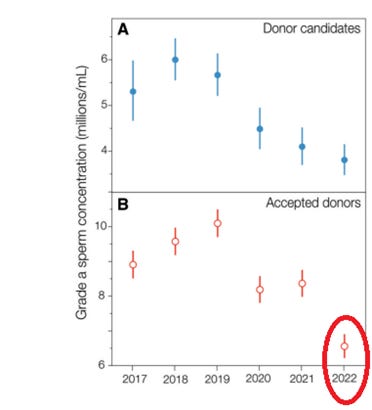by Alex Kriel, Daily Sceptic:

The media recently reported on the results of a study of Danish sperm donors from 2017 to 2022 which showed ‘sluggish sperm’ and attributed this development to the effect of lockdowns. In reality, the study showed a very significant 30%-plus decrease in motile sperm concentration and there is every reason to imagine that both lockdowns and vaccination are to blame.
The fact that this topic was even vaguely reported is surprising given that the mainstream media have been studiously ignoring the well documented negative effects of vaccination on sperm since the end of 2021. I first highlighted these problems years ago using data from a November 2021 paper published in Wiley Andrology and authored by a group of Israeli scientists, Itai Gat et al. The paper was fascinating, not only for its stunning findings, but also because this paper had enormous viewing figures and was widely reported by the ‘conspiracy theorists’ on social media. The huge reach meant that every media science editor must have been aware of the findings and all of the major outlets ignored the findings, with the Epoch Times being one of the only outlets to cover this (see my 2022 video on the media blackout).
TRUTH LIVES on at https://sgtreport.tv/
This new June 2024 paper was written by Professor Allan Pacey from the School of Medical Sciences, University of Manchester and others. They looked at the key metrics of sperm supplied by two groups of donors, the first group who had applied to Cryos International in Denmark and the second group who had been accepted as donors. Cryos International is a sperm bank business operating at four sites in Denmark.
The researchers looked at several indicators including sperm volume (mL), sperm concentration (million per mL) and sperm count (millions). Broadly speaking those main indicators were stable over the period from 2017 to 2022 – so far so good. The real problem came when looking at the motility of the sperm samples, that is the degree to which they move around. There are two main grades of motility; grade a (progress>25µm/s) and grade b (progress >5 µm/s and <25 µm/s) and the two grades added together produce the total motile sperm count (TMSC) and motile concentrations. The scientists found very significant declines in these metrics for both donor candidates and accepted donors.
Unsurprisingly, the accepted donors tend to have better sperm performance metrics than the candidate group. The chart below shows the concentration of highly motile grade a sperm for both donor candidates (A) and accepted donors (B); there is an obvious and significant decline between 2019 and 2022 for both groups. For the donor candidates (blue) the decline was a whopping 30% over three years. The paper doesn’t provide this figure for the accepted donors (red) which have an overall higher grade a concentration, but the drop appears to be even more significant at over 40% (circle).
The scientists were only able to account for around 3% of the observed changes based on impacts from known external factors such as changes in the weather. They don’t venture too many theories on the reasons behind the unexplained 97% variation other than to say that Covid “is an unlikely explanation for our observations”. For many other health problems in the post-Covid era, it has been difficult to split the impact of reduced access to healthcare from other factors. In this case reduced access to healthcare can probably be excluded so the observed decline will be due to a combination of lockdown and vaccines only. The authors of the paper are careful not to even mention the possibility of vaccine involvement but stick instead to changes triggered by lockdowns, including changed levels of physical activity and diet.




